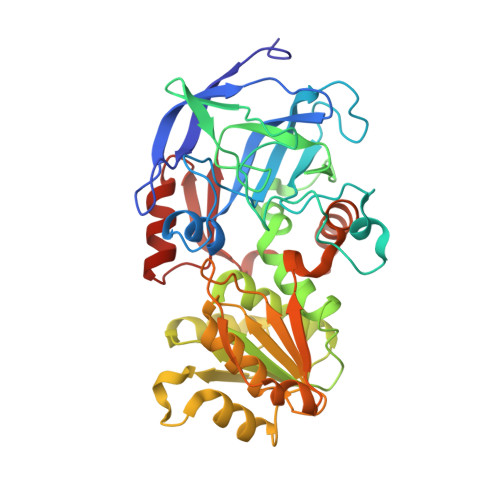Inversion of substrate stereoselectivity of horse liver alcohol dehydrogenase by substitutions of Ser-48 and Phe-93.
Kim, K., Plapp, B.V.(2017) Chem Biol Interact 276: 77-87
- PubMed: 28025168
- DOI: https://doi.org/10.1016/j.cbi.2016.12.016
- Primary Citation of Related Structures:
5KCP, 5KCZ - PubMed Abstract:
The substrate specificities of alcohol dehydrogenases (ADH) are of continuing interest for understanding the physiological functions of these enzymes. Ser-48 and Phe-93 have been identified as important residues in the substrate binding sites of ADHs, but more comprehensive structural and kinetic studies are required. The S48T substitution in horse ADH1E has small effects on kinetic constants and catalytic efficiency (V/K m ) with ethanol, but decreases activity with benzyl alcohol and affinity for 2,2,2-trifluoroethanol (TFE) and 2,3,4,5,6-pentafluorobenzyl alcohol (PFB). Nevertheless, atomic resolution crystal structures of the S48T enzyme complexed with NAD + and TFE or PFB are very similar to the structures for the wild-type enzyme. (The S48A substitution greatly diminishes catalytic activity.) The F93A substitution significantly decreases catalytic efficiency (V/K m ) for ethanol and acetaldehyde while increasing activity for larger secondary alcohols and the enantioselectivity for the R-isomer relative to the S-isomer of 2-alcohols. The doubly substituted S48T/F93A enzyme has kinetic constants for primary and secondary alcohols similar to those for the F93A enzyme, but the effect of the S48T substitution is to decrease V/K m for (S)-2-alcohols without changing V/K m for (R)-2-alcohols. Thus, the S48T/F93A substitutions invert the enantioselectivity for alcohol oxidation, increasing the R/S ratio by 10, 590, and 200-fold for 2-butanol, 2-octanol, and sec-phenethyl alcohol, respectively. Transient kinetic studies and simulations of the ordered bi bi mechanism for the oxidation of the 2-butanols by the S48T/F93A ADH show that the rate of hydride transfer is increased about 7-fold for both isomers (relative to wild-type enzyme) and that the inversion of enantioselectivity is due to more productive binding for (R)-2-butanol than for (S)-2-butanol in the ternary complex. Molecular modeling suggests that both of the sec-phenethyl alcohols could bind to the enzyme and that dynamics must affect the rates of catalysis.
Organizational Affiliation:
Department of Biochemistry, The University of Iowa, Iowa City, IA 52242, USA. Electronic address: keehyuk@woosong.ac.kr.


















